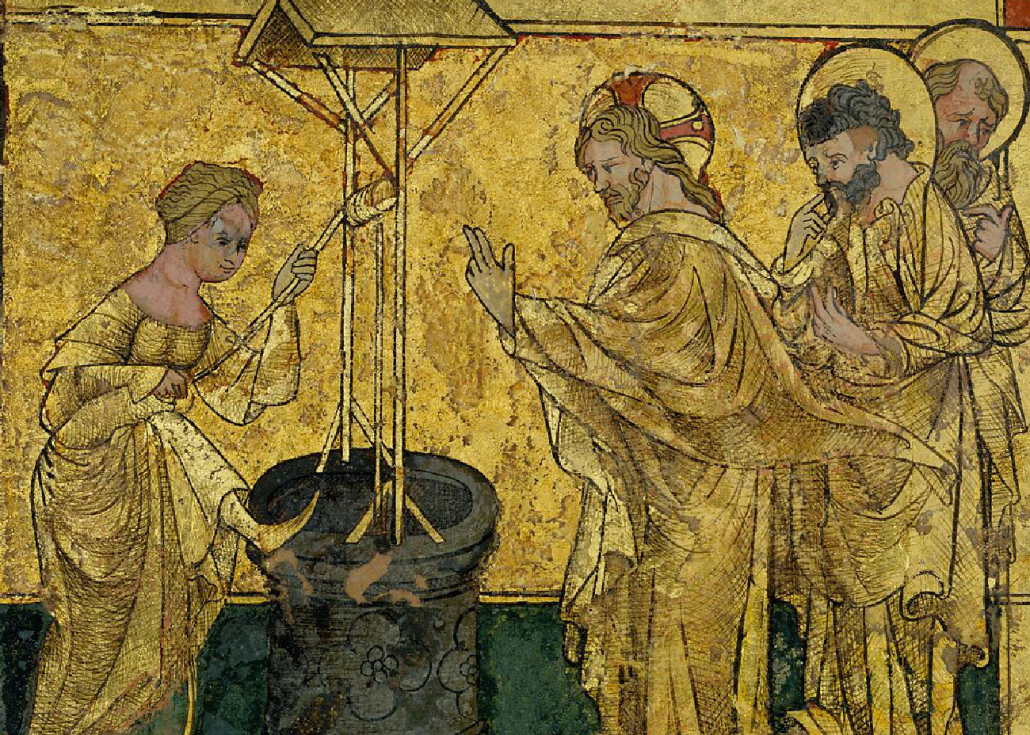Image: ‘Jesus and the Samaritan Woman at the Well’ (detail), ca. 1420, Southwest Germany, Gold leaf, paint and etching on glass.
‘Saint Photina, the Luminous One’
Andrew Collis
Lent 3, Year A
Exodus 17:1-7; John 4:5-42
Two theologians discuss the meaning of living water, sacred sites, spiritual food/harvest; worship, mission, reconciled humanity – a redeemer and messiah in whose Spirit there is life. Their conversation touches on Genesis 33 (the betrothal of Jacob and Rachel), Exodus 17 and Numbers 20 (Moses and the miracle of water from the rock at Meribah), perhaps psalms 42, 63 and 143 (thirst for living water and the divine).
Jesus and the unnamed woman (later Saint Photine or Photina, the “Luminous One” according to Orthodox tradition) exchange lines with wit and wisdom … Jesus speaks with the voice of Sophia, nourishing those who are hungry and thirsty, giving them food and drink to satisfy their need (Proverbs 9:1-5; Sirach 15:3).
Photina herself is included.
Her continuing witness is said to have brought so many to the Christian faith that she is described as “equal to the apostles”. In Oaxaca, Mexico, a celebration of the Samaritan woman takes place on the fourth Friday of Lent. The custom of the day involves churches, schools and businesses giving away fruit drinks to passers-by.
John’s gospel gives us another meeting of minds. Last week it was Nicodemus and Jesus. Today, Jesus encounters a woman at Jacob’s Well in Samaria.
As with the story from last week, it would seem wise to regard this a respectful encounter – and this will mean suspending some of what we’ve heard (and believed) in the past concerning the woman’s meek or naive, ostracised and/or morally compromised status. The text is not so condescending.
We’re given a sophisticated and multi-layered dialogue centred on reconciliation between peoples long estranged. The accent is on hope.
Samaria was a northern territory many Judeans regarded a land of infidels. It had suffered invasion and demoralisation at the hands of the Assyrians and Babylonians, Persians and Greeks before the time of Roman occupation. This history meant intermarriage and cultural change, separation from southern culture and religion – in short, ten lost tribes of Jacob/Israel.
For Judeans (having rebuilt the temple in Jerusalem following their own exile in Babylon), Samaria symbolised subjection, failure, loss, shame, compromise, impurity, apostasy.
When Jesus approaches the woman and asks her for a drink, he enacts a desire to overcome profound estrangement. The levels of meaning have to do with a history of estrangement between Judeans and Samaritans. It is not so much moral as political-theological.
Still, it is risky and risqué. Jesus and the woman re-enact a traditional well-side ritual – Jacob and Rachel? – of betrothal.
It is, then, more properly Rachel’s well, situated on land of her birth. Jacob, like Jesus, was a stranger there.
The Midrash portrays Rachel as a prophet and redeemer of Israel. There are several midrashim where she intervenes with God to have Israel’s sins absolved. She pleads with God and weeps for her children to return.
When Jesus sees Photina coming to draw water, is he seeing Rachel, coming with her sheep? Is he seeing Rachel the redeemer? Do his words about the harvest have to do with the redemption of Rachel’s children – the Samaritans and the Judeans?
In summary, their banter is playful (it goes on a bit, one thought flowing into the next) but seriously political-theological.
In Aramaic, the word for husband is very similar to the word for ruler. Faithfulness and unfaithfulness in marriage are common tropes with respect to true worship and idolatry. Water is a common metaphor for Spirit, and thirst has readily to do with longing.
Jesus engages in terms of human need and encounters another with deep capacities for understanding, grief and hope.
Perhaps this accounts for the sensitivity to heartbreak and personal connection (we should always be wary of attributing to Jesus the power to read minds or know what is not humanly possible). Jesus reveals his true identity to the woman, and in doing so, her own identity evolves.
He is engaging (vulnerable, resourceful) just as you or I might engage. And just as you or I – or, indeed, the church – might attract incredulity and offence.
Photina is certainly not meek or naive, and reports of her status as an outcast seem exaggerated. She is strong, independent, erudite. When she returns to tell others in Sychar about her encounter with Jesus – an inspiring and transformative encounter – she is a compelling witness. The townspeople listen to her; they respond to her testimony. She is an evangelist after John the evangelist’s own heart!
In the Spirit of truth, let us consider loving encounters in this place. Whose gifts for leadership do we discern? Whose companionship and faithful support might we acknowledge? Whose theological and cultural wisdom might we affirm? Who, like Photina, amplifies the light in us – brings out the better and the best in us? … Amen.




